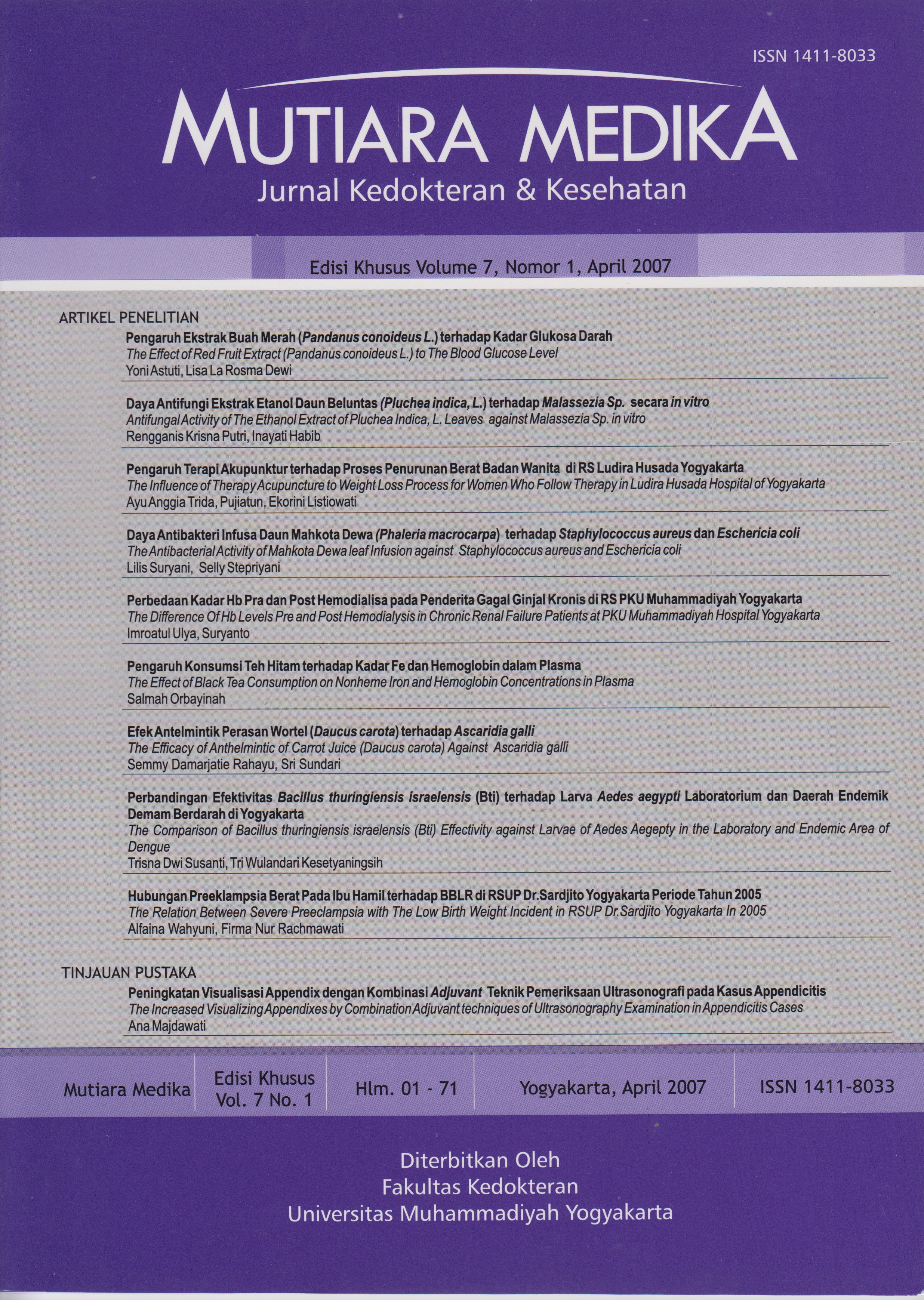Efek Antelmintik Perasan Wortel (Daucus carota) terhadap Ascaridia galli
DOI:
https://doi.org/10.18196/mmjkk.v7i1%20(s).1683Keywords:
Antelmintik, Ascarida galli, Daucus carota, efikasi, anthelmintic, Ascaridia galli, efficacyAbstract
Carrot (Daucus carota) is one of traditional medicine that used as worm remedy, because of more safety, inexpensive and easily obtained by people. Quercitrin is flavonoid within carrot that supposed to have anthelmintic activity. This research aimed to know the efficacy of carrot juice as an anthelmintic against Ascaridia galli. It was experimental research in laboratory. This research consist of six groups, they were four treatment groups consist of carrot juice in concentration of100 %, 75 %, 50 % and 25 %; one group of negative control using physiological salt solution and one group of pyrantel pamoate 0.236% as positive control group. Ascaridia galli worms were soaked in 25 ml of test material solution and observed the death time. The data was analyzed by one way anova test to determine the significantly of difference among the research groups. The result of this research indicated that carrot juice 100 %, 75%, 50% and25% were able to kill the worm in average on 4.7; 5.3; 6.3 and 8.3 hours respectively. The average worm ’s life span in negative control group and positive control group was 16.7 and 4 hours respectively. The result of Anova analysis shows that in concentration 100 % and 75 % of carrot juice there was unsignificantly different (p>0.05) with pyrantel pamoate. In concentration of 50 % and 25 % there was significantly different (p<0.05) with pyrantel pamoate. It is concluded that carrot juice (Daucus carota) have an anthelmintic effect against to Ascaridia galli invitro. The lower concentration, the lesser anthelmintic effect.
Wortel (Daucus carota) merupakan salah satu obat tradisional yang sering digunakan sebagai obat cacing di masyarakat. Hal ini karena ada anggapan bahwa pengobatan tradisional lebih aman, murah, dan mudah didapat. Quercitrin yaitu flavonoid yang terdapat pada wortel diduga mempunyai aktivitas antelmintik. Penelitian ini bertujuan membuktikan efek antelmintik perasan wortel terhadap cacing Ascaridia galli. Penelitian ini merupakan penelitian eksperimental laboratorium. Penelitian ini menggunakan 6 kelompok percobaan, yaitu empat kelompok perlakuan perasan wortel 100 %, 75 %, 50 % dan 25 %, kelompok kontrol negatif (NaCl fisiologis) dan kelompok kontrol positif (Pirantel Pamoat 0,236 %). Cacing Ascaridia galli direndam dalam larutan bahan uji sebanyak 25 ml dan dicatat waktu kematiannya. Data dianalisis dengan Anova satujalan untuk menentukan signifikansi perbedaan antar kelompok penelitian. Hasil penelitian menunjukkan bahwa perasan wortel 100 %, 75 %, 50 % dan 25 % mampu membunuh cacing dengan rerata waktu berturut-turut adalah 4,67; 5,3; 6,3 dan 8,3 jam. Rerata lama hidup cacing pada kelompok kontrol negatif dan kontrol positif berturut-turut adalah 16,7 dan 4 jam. Hasil dengan uji Anova menunjukkan perasan wortel konsentrasi 100 % dan 75 % menunjukkan perbedaan yang tidak bermakna (p>0,05) dengan Pirantel Pamoat, sedangkan pada konsentrasi 50 % dan 25 % mempunyai perbedaan yang bermakna (p< 0,05) dengan Pirantel Pamoat. Disimpulkan bahwa perasan wortel (Daucus corota) mempunyai daya antelmintik terhadap cacing Ascaridiagalli. Makin rendah konsentrasi perasan makin berkurang daya antihelmintiknya.
References
Subahar, 1995. Masalah Cacingan yang Ditularkan Dengan Perantara Tanah di Indonesia. Jakarta.
Tjitra, 1991. Penelitian Soil Transmitted Helmints di Indonesia, Cermin Dunia Kedokteran, No. 72, PP. 12.
Astari, A.N., 1999. Pengaruh Kunyit Putih (Curcuma mangga) sebagai Antihelmintik terhadap Cacing A.galli., Yogyakarta.
Azrul, 2005. Pengobatan Tradisional Tetap Diminati Masyarakat. www.kompas.co.id/kompas-cetak/ 0504/071/humaniora/167074.htm
Duke, J. A. 1983. Referenced Quats on Carota. www.ars.grin.gov/cgi bin/ duke/chemical.
Hembing Wijayakusuma, H.M., 1996. Tanaman Berkhasiat Obat di Indonesia IV. Pustaka Kartini, Jakarta.
Nugroho, 1983. Penyakit Ayam di Indonesia, Edisi I. Eka Offset, Semarang.
Katzung, B., 1995, Farmakologi Dasar dan Klinik. Edisi 4, Kedokteran EGC. Jakarta.
University of Illinois., 2008, Flavonoid antioxidants in Celery and Peppers Reduce Inflammatory Responds in the Brain. Diakses dari http:// www.dietaryfiberfood.com/ antioxidants/flavonoid-antioxidant.php
Downloads
Published
Issue
Section
License
Copyright
Authors retain copyright and grant Mutiara Medika: Jurnal Kedokteran dan Kesehatan (MMJKK) the right of first publication with the work simultaneously licensed under an Attribution 4.0 International (CC BY 4.0) that allows others to remix, adapt and build upon the work with an acknowledgment of the work's authorship and of the initial publication in Mutiara Medika: Jurnal Kedokteran dan Kesehatan (MMJKK).
Authors are permitted to copy and redistribute the journal's published version of the work (e.g., post it to an institutional repository or publish it in a book), with an acknowledgment of its initial publication in Mutiara Medika: Jurnal Kedokteran dan Kesehatan (MMJKK).
License
Articles published in the Mutiara Medika: Jurnal Kedokteran dan Kesehatan (MMJKK) are licensed under an Attribution 4.0 International (CC BY 4.0) license. You are free to:
- Share — copy and redistribute the material in any medium or format.
- Adapt — remix, transform, and build upon the material for any purpose, even commercially.
This license is acceptable for Free Cultural Works. The licensor cannot revoke these freedoms as long as you follow the license terms. Under the following terms:
Attribution — You must give appropriate credit, provide a link to the license, and indicate if changes were made. You may do so in any reasonable manner, but not in any way that suggests the licensor endorses you or your use.
- No additional restrictions — You may not apply legal terms or technological measures that legally restrict others from doing anything the license permits.



